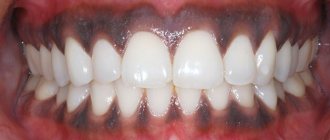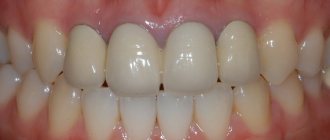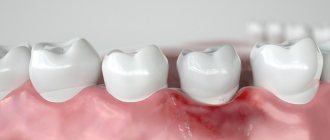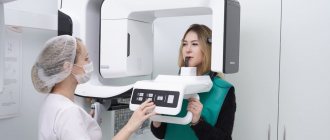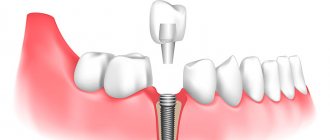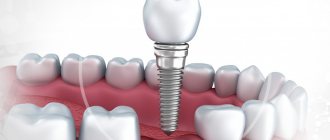It is a common belief that people with implants should not have an MRI. In fact, this was the case several decades ago, when patients were fitted with prosthetics made of steel, nickel and cobalt. In those years, magnetic resonance imaging could cause serious harm to human health.
TBS implant.
Let's be clear from the beginning that people with implants, pins, screws, retaining plates, breast implants, and dental implants CAN have an MRI.
What implants can be used for MRI?
MRI is allowed for people who have undergone hip or knee replacement. It is important that the endoprosthesis or fixation for osteosynthesis is made of metals or ceramics with low magnetic susceptibility. This avoids displacement or overheating of the structure during the examination.
Knee endoprosthesis.
People with hernia mesh, dental, breast and joint replacements are also allowed to have an MRI. All these implants are made from materials that do not interact with the magnetic field. This makes the study safe. However, you should consult a specialist before an MRI. The doctor will assess the possible risks and recommend the necessary precautions.
Minimally invasive endoprosthetics in the Czech Republic: doctors, rehabilitation, terms and prices.
Find out more
Examination with contrast
Contrast is used to improve visualization; in approximately 20% of all diagnostic cases it is necessary. Gadolinium-based drugs are used, which are safer than iodine-containing substances.
An intravenous injection is performed after routine imaging. For this, the patient is “rolled out” of the device and given a regular injection, after which the test is repeated.
Discuss with your doctor whether contrast is necessary, since in this case the cost of the examination doubles.
The procedure is indicated for suspected multiple sclerosis or for vascular examination. To obtain accurate information about myocardial viability or congenital pathologies, it is also advisable to perform an MRI of the heart with contrast.
Interaction of different metals with a magnetic field
Different metals tend to interact with magnets differently. Some of them are attracted to it, others are repelled, and others do not react at all. All three types of metals are used for the manufacture of endoprostheses.
Table 1. Metal classes.
| Class | Representatives | Description |
| Diamagnets | Copper Zirconium Silver Zinc | They have negative magnetic susceptibility. This means that when interacting with a magnetic field, they repel rather than attract. |
| Paramagnets | Titanium Tungsten Aluminum Tantalum Chrome Molybdenum | These metals are characterized by the presence of low magnetic susceptibility, independent of the magnetic field strength. Paramagnetic prostheses usually tolerate the MRI procedure well and do not move or heat up. |
| Ferromagnets | Iron Nickel Cobalt Steel | They have high magnetic susceptibility, depending on the magnetic field strength. Implants containing large amounts of these metals may become dislodged or become hot during an MRI scan. |
Composition of modern endoprostheses
All plates, pins and endoprostheses, which are used in modern traumatology and orthopedics, consist of a variety of alloys. Note that different implants contain different amounts of paramagnetic and ferromagnetic materials. The properties of each endoprosthesis, pin or plate depend on the composition.
Not all prostheses are 100% metal. Most of them contain ceramics or polyethylene. The latter does not interact with the magnetic field, therefore, it does not in any way affect the MRI results and the course of the procedure. However, ceramics most often contain aluminum oxide, which still has a certain magnetic susceptibility.
Destroyed components of the hip joint implant.
Possible combinations of materials in endoprostheses:
- ceramics + ceramics;
- ceramics + polyethylene;
- metal + polyethylene;
- metal + ceramics;
- metal + metal.
Fact! Plates and pins for fixing bone fragments are made of metal alloys. The same applies to external fixation devices (Illizarov type) and clips that are placed on vessels.
Composition of artificial joints:
- cobalt;
- chromium;
- molybdenum;
- titanium;
- zirconium;
- tantalum;
- niobium.
Having familiarized yourself with the composition, you can understand how it will behave in a resonant tomograph. The magnetic properties of each endoprosthesis are determined not only by the material from which it is made, but also by its shape and size. Steel pins and plates longer than 20 cm can heat up above the permissible limit.
Fact! Products containing large amounts of nickel and cobalt interact especially actively with a magnetic field. This means that diagnostics with such endoprostheses should be performed with extreme caution.
Myths about MRI
Our team has collected for you the top 3 common false theories about magnetic resonance scanning:
- During an MRI, the implants heat up and move. The specific gravity of the metal fastening elements of the structures is minimal, which means there are no defects in the examination results and no discomfort for the patient. But it is imperative to notify doctors about the material from which the product is made. Safe prostheses are considered to be those made of zirconium dioxide, ceramics or other expensive alloys. If you have a metal-ceramic structure, you need to clarify which metals and impurities were used in the creation.
- MRI cannot be performed during pregnancy. This is only half a lie. Due to the fact that in the first trimester the formation of tissues and organs in the unborn child begins, any effect on the fetus (chemical, physical or biological) must be excluded. In late pregnancy, tomography allows you to determine the position of the baby and determine the size of the mother’s pelvis. The results of the examination allow the obstetrician to prepare for childbirth without consequences for the child and the pregnant woman.
- MRI with prostheses is painful. Complete lie. Tomographic examination is one of the most painless and safe diagnostic techniques. MRI is allowed even with titanium inserts. Scanning can only be denied if the structure is implanted with steel, since it can heat up and move under the influence of magnetic vibrations. Only such a process can lead to injury to the subject.
If you have implants or not, but want to undergo an MRI, use. Our platform is designed to quickly search and select a clinic for diagnostics. The service presents dozens of medical centers, collects current prices for tomography and real reviews from visitors. To make an appointment, just call the hotline. When you reserve a place with a doctor using our resource, you will receive up to 1,000 rubles as a gift!
Manufacturing companies
Over the past 20 years, medicine has mainly used implants made from chromium-cobalt alloys (as we have already found out, these metals actively react to a magnetic field). Many models made from better materials have appeared on the market. They are better tolerated by patients and do not cause allergies or MRI problems.
Table 2.
| Company manufacturer | Characteristics and Application | Behavior of implants during MRI diagnostics |
| Biomet | Produces high-quality implants that take root well and do not cause allergic reactions. | Due to their small size and low magnetic susceptibility, they do not interfere with MRI. |
| Zimmer | It produces products not from titanium, but from tantalum. The implants have a porous coating and fuse perfectly with the bone tissue. | They do not cause unexpected complications during magnetic resonance imaging and do not distort the results of the study. |
| Johnson&Johnson | The company produces implants using all available standards and technologies. | Do not interact with magnetic field. When available, MRI is absolutely safe. |
| Smith&Nephew | Manufactures endoprostheses from an alloy containing zirconium and niobium. | Smith&Nephew implants are hypoallergenic and practically do not interact with the magnetic field. |
| Stryker | World-famous company of beta-titanium endoprostheses and fixators for internal osteosynthesis. | Owners of Stryker implants can undergo MRI without any worries. Additional precautions may only be necessary if you have several large prostheses. |
| Aesculap | Produces endoprostheses from titanium, zirconium ceramics, chrome-cobalt alloys. | Most implants can easily withstand magnetic resonance imaging. |
If you have a prosthesis from one of the companies listed in the table, you can do an MRI without the slightest fear. However, in any case, you should not undergo the study without first consulting a doctor.
Operating principle of tomography equipment
First of all, you need to understand how exactly an MRI device works. The equipment is designed for targeted screening of soft tissues, bones and blood vessels. Advanced devices in diagnostic centers today have enormous technical capabilities. Thus, the power of the equipment is usually 1.5–3 Tesla, thanks to which doctors can examine anomalies whose dimensions are less than 0.2 mm.
MRI technology is based on the generation of radio waves and the ability to magnetize hydrogen elements present in different tissues of the body. The nuclei are able to respond to the influence of a magnetic field, that is, enter into resonance, and a computer program records all the data and converts it into detailed images. The research results are generated from many virtual sections of the selected department, for example, the brain, the vascular system, the abdominal cavity, and so on. Based on them, the radiologist draws up a medical report and a preliminary diagnosis.
Contraindications to the procedure
If prostheses, pins and plates are firmly connected to the bone tissue and cannot move, then implants of other locations can easily move under the influence of a magnet. Therefore, it is STRICTLY PROHIBITED to conduct magnetic resonance imaging if they are present.
Implants that cannot be used for MRI:
- artificial heart valves;
- stents and clips on vessels of any location;
- middle or inner ear implants;
- pacemakers;
- artificial lens;
- Illizarov apparatus;
- insulin pump;
- large metal implants.
Minimally invasive endoprosthetics in the Czech Republic: doctors, rehabilitation, terms and prices.
Find out more
Preparation
Many types of MRI examinations do not require special preparation, but there are exceptions.
Before an MRI of the abdominal cavity, it is advisable to follow the following diet:
- for two days, eliminate gas-forming foods, fresh fruits and vegetables;
- on the day of the procedure, avoid tea and coffee;
- It is advisable not to eat for at least 6 hours before the examination, and not to drink for 4 hours.
The doctor will recommend special medications for constipation and flatulence. To exclude artifacts from intestinal motility, two hours before the procedure you need to drink 2 tablets of No-shpa.
Before an MRI of the pelvis, it is advisable not to urinate for about two hours. If the study is carried out in women, it is recommended that it be carried out on days 5-12 of the cycle (immediately after menstruation), but this condition must be discussed with a doctor.
General recommendations
before MRI scan:
- remove all metal objects;
- leave jewelry and accessories at home;
- change into comfortable clothes;
- Leave valuables, money, and bank cards in a specially designated place or safe in front of the diagnostic room.
An approximate list of items that are not allowed in the diagnostic room:
- metal zippers on clothes, pins, hairpins;
- watch;
- Hearing Aids;
- pens;
- earrings, including piercings;
- glasses;
- removable dentures;
- pocket knives.
How to find out if you can have an MRI
Remember that an MRI can be done with the permission of a specialist. Only he will determine whether you need this research and whether it will harm you. Perhaps the doctor will make a diagnosis without magnetic resonance imaging. Spinal spondylosis and deforming osteoarthritis of stages II-IV can be detected using conventional radiography.
Comparison of visual diagnostic methods. MRI is on the right.
results
The study is interpreted by a diagnostician - a radiologist. The conclusion is issued on the day of the examination, but a description of the images may take the doctor several hours.
The doctor examines the obtained images and compares them with normal values:
- size and location of organs, symmetry;
- presence/absence of abnormal formations;
- presence/absence of an aneurysm, free fluid, blood clots in the blood stream;
- signs of infection and inflammation;
- stagnation in the ducts;
- traumatic injuries.
Possible complications and precautions
MRI in the presence of electronic implants can seriously harm a person or even lead to his death. Performing the study on persons with coronary walls and clips on cerebral vessels can provoke massive bleeding, which will lead to death. Endoprostheses made from some alloys may move out of place or heat up during an MRI, causing burns.
MRI installation before the procedure.
People with certain types of implants are strictly prohibited from undergoing magnetic resonance imaging. But for patients with implants made of “dangerous” alloys, you can still try to perform the study. As a precaution, a button is placed in the person's hand. If he feels a strong burning sensation, he presses it and the study is stopped.
Fact! Metal prostheses tend to “fade”, making the image of nearby tissues unclear. Therefore, it is pointless to try to obtain an MRI image of the replaced joint or bone held together by fonts or plates.
How preparation for research affects the result
It is important to remain still during the examination, otherwise the image quality may be somewhat distorted. Throughout the examination, the patient is under the supervision of a specialist. Inside, there is a button at hand to contact staff in case of an emergency. When examining children in the examination room, in exceptional cases (depending on age), an accompanying person may be present.
If you have a pacemaker, there are serious contraindications for MRI examination. You should consult your cardiologist as MRI may affect the implants and their function. When receiving a referral for diagnostics, you should have the implant passport with you.
Metal parts that are in the body (surgical screws, replaced joints, artificial heart valves, tattoos with metal particles) must be told to the doctor before the examination. Magnets can interfere with the normal functioning of pacemakers and can move pieces of metal that are present in the body.
A strong magnetic field can affect magnetic cards, electronic devices, and any magnetized metal body located inside or outside the body. Therefore, before entering the examination room, you must remove jewelry and watches. Personal belongings may be handed over to accompanying persons or placed in storage rooms located outside the examination room.


